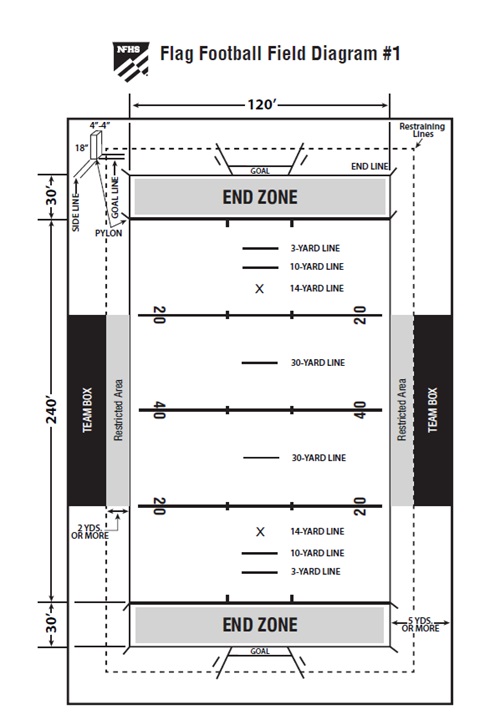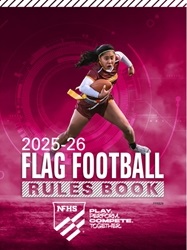
Photo © Yobro10 | Dreamstime.com
Perhaps the most eagerly awaited youth sports development of the summer concerns the inaugural set of the National Federation of State High School Associations (NFHS) Flag Football Rules. Now, the wait is over and the rules are available for purchase on the NFHS website.
NFHS has noted that flag football is the nation’s fastest-growing emerging sport, and that while the new rules were written for both boys and girls competition, the growth of the girls’ game the past several years drove the urgency for national playing rules.
“The popularity of flag football – for boys and girls – has been growing at the youth levels for the past 10 years,” said Dr. Karissa Niehoff, CEO of the NFHS. “In 2023, about 500,000 girls ages 6-17 played flag football – a 63 percent increase since 2019.”

Additionally, the number of participants in girls’ flag football more than doubled from 2022-23 to 2023-24. A total of 42,955 girls participated in flag football in 2023-24 compared to 20,875 the previous year – a 105 percent increase.
Currently, for the 2025-26 season, 16 state associations have sanctioned girls’ flag football and 18 states are involved in independent/pilot programs at some level. States that have sanctioned the sport for girls include NFHS member associations in Alabama, Alaska, Arizona, California, Colorado, Connecticut, Florida, Georgia, Hawaii, Illinois, Mississippi, Nevada, New York, Pennsylvania, Tennessee and Washington.
State associations with independent/pilot programs include District of Columbia, Delaware, Indiana, Kansas, Louisiana, Maryland, Massachusetts, Michigan, Minnesota, Missouri, Montana, New Jersey, North Carolina, Ohio, Oregon, Rhode Island, Texas and Wisconsin.
And according to Bob Colgate, NFHS Director of Sports and Sports Medicine, that kind of growth meant that having rules was more important than ever.
“Every state used to have their own rules with different size fields, different size teams, and teams playing across state lines. Now, we have one set of national rules and that should make things easier.”
Some states, he notes, have been hesitant to add flag out of a concern that it might pull athletes from other sports being presented in that season.
“States have to look at it on a case by case basis,” he says. “In some of our states, they just don’t have the numbers of athletes they need to add it in.”
Of course, that won’t stop athletes from joining
Field Sizes
Three configurations of fields are possible under the new rules. All are currently posted on the NFHS flag football page. States using NFHS rules will get to choose which field they want to designate as their official field dimensions:
- 120 ft. wide x 240 ft. long
- 120 ft. wide x 300 ft. long
- 160 ft. wide x 300 ft. long
Each field size additionally has two 30-foot end zones.
The diagrams, which can be found online at the link above, are written for 7-on-7 play, which, according to Colgate, is the most popular format, although he allows that some states may be playing 5-on-5.
The reason for having three field sizes, says Colgate, was that with 34 states currently offering flag, differing field sizes had been used. NFHS wanted “to make the transition [to having rules] as easy as possible.”
Since in many cases, high schools have turf fields, cones can be used to designate the sidelines, end zones, etc. Grass fields, notes Colgate, can be marked for flag football at the discretion of the athletic director.
Playing Rules
In addition to determining one of the three options for the playing field, there are 18 other rules to be determined by state adoption, including the establishment of rules regarding place kicking for field goals and tries (points after touchdowns).
 States utilizing NFHS flag football rules also will have the option, among others, to determine the number of game officials, authorize the use of goals, authorize the use of a kicking tee, authorize the use of hash marks and determine the style of flag to be used and the measurements of the flag, although the flag cannot be below the minimum outlined in the rules.
States utilizing NFHS flag football rules also will have the option, among others, to determine the number of game officials, authorize the use of goals, authorize the use of a kicking tee, authorize the use of hash marks and determine the style of flag to be used and the measurements of the flag, although the flag cannot be below the minimum outlined in the rules.
While the rules for flag football closely follow NFHS football rules, the rules regarding obtaining a first down are different. Instead of advancing the ball to the line to gain, a first down is awarded in flag football when a team advances the ball to the zone to gain. Following is the language in Rule 5-3 in the NFHS Flag Football Rules Book:
“The zone to gain is the next 20- or 40-yard line in advance of the ball's foremost point when a new series of downs is awarded. When a new series of downs is awarded, the penalties for all fouls (including nonplayer and unsportsmanlike) committed prior to the ready-for-play shall be administered before the zone to gain is established. The zone to gain then remains fixed until the series ends and a new zone to gain is established.”
NFHS flag football rules that mirror traditional high school football rules include four 12-minute periods and point values of six points for a touchdown and three points for a field goal, if kicking rules are adopted by the state association.
Expect growth to continue as flag football gains even more visibility with the 2028 Summer Olympics in Los Angeles.
“The NFHS looks forward to being involved with the continued growth of flag football in schools nationwide, particularly now with playing rules specifically for the high school game, as more opportunities for participation unfold in all 50 states,” Niehoff concluded.

